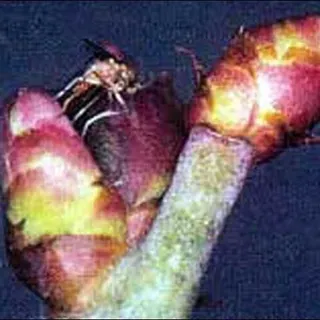Blueberry Gall Midge, Dasineura oxycoccana (Johnson) (Insecta: Diptera: Cecidomyiidae)
The Featured Creatures collection provides in-depth profiles of insects, nematodes, arachnids and other organisms relevant to Florida. These profiles are intended for the use of interested laypersons with some knowledge of biology as well as academic audiences.
Introduction
A gall midge, Dasineura oxycoccana (Johnson) (Diptera: Cecidomyiidae), is a pest of rabbiteye blueberries (Vaccinium ashei Reade) in the southeastern US (Lyrene and Payne 1992). More recently, it has emerged as a pest of southern highbush blueberries (Vaccinium corymbosum L x V. darrowi Camp) (Lopez 2023, Liburd 2018). Midge larvae feed inside and destroy flower buds resulting in low yields. Midges also cause severe damage to vegetative growth. Plants cannot produce enough foliage to support a heavy fruit crop, resulting in smaller berries with low sugar. Some blueberry varieties have suffered a 100% crop loss due to depredations of this midge. The problem is most pronounced in southern portions of the rabbiteye blueberry production range where winter temperatures favor emergence of adult midges and larval development during critical stages of blueberry flower development. South of Gainesville, Florida, commercial rabbiteye blueberry production is not feasible if midges are left uncontrolled. In Florida in 2018, 58% of blueberry farms in Florida reported heaving infestations of gall midge and yield losses (Liburd 2018).
Distribution
Dasineura oxycoccana is known from the northern United States (Maine, New Jersey, Michigan, Wisconsin, Washington) where it infests vegetative buds of blueberry and cranberry (Vaccinium macrocarpon Aiton). In southeastern Georgia, southern Mississippi, and Florida, midge populations attack both flower and vegetative buds of blueberry. Florida county records include (from north to south) Okaloosa, Washington, Alachua, Putnam, Marion, Citrus, and Hillsborough counties.
Description
Adults are tiny, fragile flies approximately 2–3 mm (~1/16 – 1/8 in) long. Mature larvae are about 1 mm (< 1/16 in) long and 0.3 mm (< 1/16 in) wide, legless, and yellow to red in color. Gagné (1989) provides excellent details on larval and adult gall midge morphology.
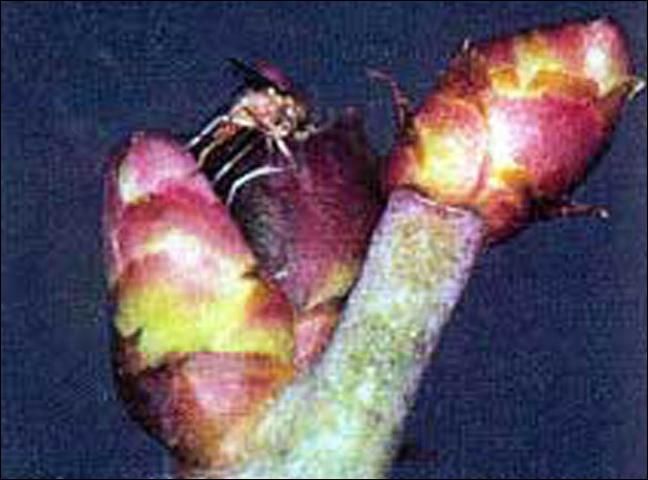
Credit: Division of Plant Industry
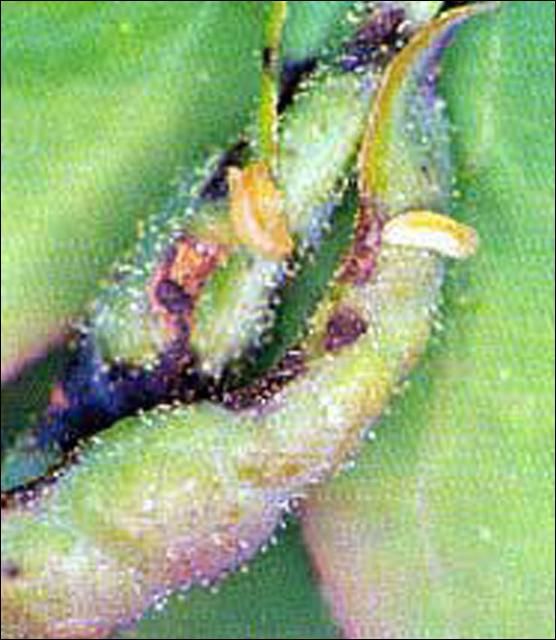
Credit: Division of Plant Industry
Life History
The biology of the blueberry midge is still poorly known in the southeastern U.S. In North Florida, midges apparently produce five or six generations between early January and early June. The adult stage (during which mating and egg-laying take place) probably lasts only from one to a few days. Eggs are oviposited between the scales of flower buds after the buds begin to expand. Totally dormant buds are not infested. Eggs hatch in two to three days. Since larvae digest plant tissues, they are the plant-damaging stage. There may be from one to nine larvae in a single flower bud. Larvae apparently feed on bud tissues and on the pedicels that hold the individual flower buds to the peduncle within the developing flower cluster. Larvae probably drop to the ground after feeding, then pupate and transform to the adult stage. Under laboratory conditions, infested flower buds yielded adults after 12 days. Flower buds are subject to continuous oviposition from January to March. As plants progress to vegetative budding, oviposition also occurs on the new shoot meristems. Infested vegetative buds swell and the outer leaves curl enfolding feeding larvae inside. Oviposition continues until the end of May. During summer, fall, and early winter in Florida, larvae apparently enter developmental diapause and remain in the soil.
Plant Damage
Flower buds dry up and disintegrate within about two weeks after infestation. High levels of flower bud abortion may occur during winter and early spring. The severity of damage varies from year to year and tends to be worse after mild winters and in more southern locations. Vegetative meristems may also be infested and killed or damaged leaving only very short shoots with a few highly distorted leaves. After mid-May, little damage occurs in Florida even though new growth flushes continue throughout the summer. The severity of damage also varies from field to field. Young plantings in their 2nd or 3rd year often flower and fruit well, even while nearby fields of mature plantings have severe bud loss. This suggests a low vagility (dispersion ability) of the midges and a slow population increase to pest proportions.
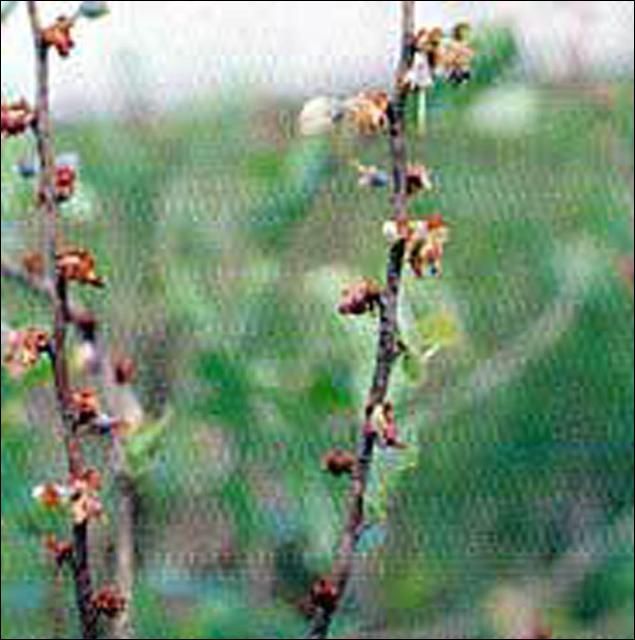
Credit: Division of Plant Industry
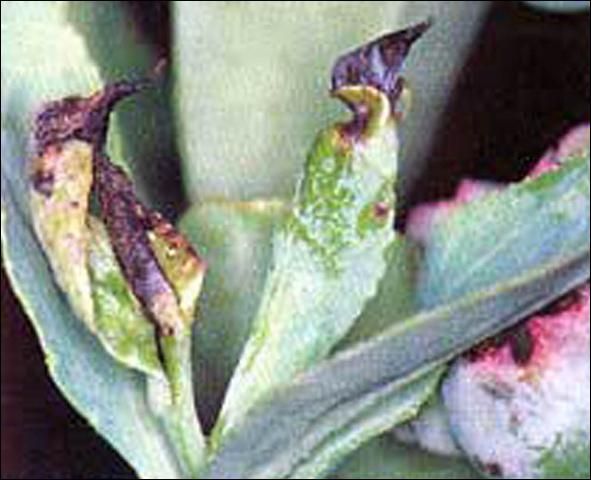
Credit: J. A. Payne, USDA
Varietal Resistance
Rabbiteye blueberry cultivars vary greatly in their resistance to blueberry gall midge infestation. 'Powderblue' and 'Brightwell' are highly resistant to flower bud damage; 'Climax', 'Aliceblue', 'Beckyblue', 'Bonita', 'Tifblue' and 'Woodard' are moderately susceptible; and 'Premier' and 'Windy' are highly susceptible. Most southern highbush blueberry (Vaccinium corymbosum L.) cultivars are highly resistant to flower bud damage.
Vegetative meristem resistance is not necessarily associated with flower bud resistance, and there is wide variation in resistance among cultivars. Among rabbiteyes, 'Climax' is one of the most susceptible to meristem damage, and plants may remain almost leafless until late spring in years with high midge pressure. Despite their good flower bud resistance, highbush cultivars do suffer considerable meristem loss, although most cultivars are still able to foliate well.
Management
Adults are readily killed with insecticides. However, their multivoltine life history and short adult lifespan necessitate careful scouting and timing of insecticide application. Contact your county Cooperative Service Extension agent or office for latest applicable insecticides. Egg and feeding larval stages are less easily killed, since these stages are at least partially protected by surrounding plant tissue. Larvae and pupae in the soil may be susceptible to a soil drench insecticide treatment. Any insecticide treatment during the blueberry flowering period must be judiciously applied because insect pollinators are active at this time. Alternatively, insecticides could be applied after flowering when vegetative meristems are under attack and huge midge populations are developing. This timing would reduce the over-summering larva population and subsequent midge attack the following winter and spring.
Cultural controls may be effective. Shallow disking beneath blueberries, probably in late fall or early winter, may kill diapausing larvae in the soil or expose them to predators. Likewise, using a disk to spread a thin layer of sand under the blueberry bushes may inhibit adults from emerging from the buried pupae.
For more information see: Blueberry gall midge on southern highbush blueberry in Florida.
Selected References
Gagné, R.J. 1989. The plant-feeding gall midges of North America. Cornell University Press, Ithaca, NY. 356 pp.
Liburd, O. E. 2018. Blueberry gall midge monitoring and management a must. Growing Produce. https://www.growingproduce.com/fruits/berries/blueberry-gall-midge-monitoring-and-management-a-must/
Lopez, M. 2023. Development and application of a management program for blueberry gall midge in Florida’s blueberry planting. Ph.D. Dissertation, University of Florida, Gainesville, Florida.
Lyrene, P.M., and J.A. Payne. 1992. Blueberry gall midge; a pest on rabbiteye blueberry in Florida. Proceedings, Florida State Horticulture Society 105: 297–300.
Lyrene, P.M., and J.A. Payne. 1995. Blueberry gall midge: a new pest of rabbiteye blueberries. Journal of Small Fruit Production, in press.



